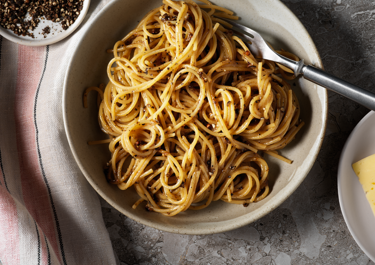Cacio e pepe
&format=webp)
Cacio e pepe is a classic Italian pasta dish that exemplifies how less can be more in Italian cuisine. It is simple yet bursting with flavour and only uses a few high-quality ingredients to create a comforting and delicious dish. The star ingredients are cheese and toasted, coarsely ground black pepper, which come together to create a scrumptious and mouth-watering experience. Whether you are a pasta lover or simply looking for a quick and easy meal, cacio e pepe is sure to become a favourite.
Ingredients
|
3 l
Water
|
|
|---|---|
|
1 tbsp
Coarse salt
|
|
|
400 g
Spaghetti
|
|
|
1 tbsp
Black peppercorns
|
|
|
175 g
Grated cheddar and maasdam cheese
|
|
|
40 g
Butter
|
Instructions
Step 1
Step 2
Step 3
Step 4
Step 5
Tip
To succeed with the recipe, be sure to cook the pasta al dente to avoid a mushy texture. Reserving some pasta water before draining the spaghetti instead of simply using water from the tab will make the dish creamier and prevent any clumping. When toasting the peppercorns, be careful not to overdo it, as they can quickly become too bitter. And finally, use cheese that melts well to create a smooth and creamy sauce. You can add the cheese gradually in small amounts while stirring to ensure that it is fully incorporated into the dish.
Questions about cacio e pepe
Discover the treasures of Italian cuisine with our recipe for cacio e pepe. Below we have answered some of the most frequently asked questions about the classic pasta dish. Continue reading to learn more.
What is cacio e pepe?
Cacio e pepe is a traditional Italian pasta dish, meaning ‘cheese and pepper’ in Italian. It is a simple, yet flavourful dish made by tossing pasta with grated cheese and black pepper, along with a little bit of starchy pasta water and butter to create a creamy sauce. The dish originated in Rome and has been a popular favourite for generations. It is often made with spaghetti, bucatini, or tonnarelli, but it can also be made with other types of pasta.
How to make cacio e pepe?
Start by boiling spaghetti in slightly salted water until tender but still slightly firm. Meanwhile, roast peppercorns in a hot, dry pan for about 1 minute, shaking the pan occasionally. Crush the peppercorns roughly in a mortar. Once the spaghetti is done, remove 200 ml of the pasta water o use in the sauce and drain the spaghetti in a sieve. In a large pot, add the crushed peppercorns, pasta water, drained spaghetti, grated cheese, and butter. Stir well until the butter and cheese have melted.
What to serve with cacio e pepe?
The traditional Italian pasta dish can be enjoyed on its own or paired with a simple side salad or vegetable dish. As the dish is rich in taste and texture, it is best to keep the sides light and refreshing to balance the flavours. A crisp green salad with a lemon and olive oil dressing is a great option, as is a side of sautéed vegetables like asparagus, zucchini, or spinach. Garlic bread or crusty Italian bread can also be a nice addition to soak up all those delicious flavours.
What cheese is in cacio e pepe?
You can use almost any cheese in cacio e pepe as long as it melts well and has a nice not too strong flavour. The cheese typically used in cacio e pepe is Pecorino Romano, which is a hard, salty cheese made from sheep's milk. It has a tangy flavour and melts well, making it perfect for use in pasta dishes and gratins. Some recipes also call for the addition of Parmesan cheese or a blend of the two types of cheese.
How to reheat cacio e pepe?
The dish is best served immediately after cooking, but if you have leftovers, the easiest way to reheat cacio e pepe is to simply microwave it in a microwave-safe dish for 30-second intervals, stirring in between until it is heated through. Alternatively, you can reheat it on the stovetop by adding a splash of milk or cream to the pasta and gently heating it over low heat, frequently stirring until the cheese is melted. Be careful not to overheat the pasta.
How to stop cacio e pepe from clumping?
Cacio e pepe can be prone to clumping if not prepared properly, but there are a few tips to prevent this from happening. Reserve some of the starchy pasta water before draining the pasta. This water will be mixed with the pasta and cheese to help create a creamy, emulsified texture and prevent clumping. Timing is of the essence, so it is important to work quickly and constantly stir when adding the cheese, butter, and pasta to the pasta water, as the cheese can easily clump and form a sticky, unappetising mixture.
Cacio e pepe – the classic, simple Italian pasta dish
Cacio e pepe is a perfect example of the beauty of Italian cuisine: using simple ingredients to create a dish that is both delicious and comforting. This classic pasta dish from Rome is a celebration of the simple and delicious combination of melty cheese and black peppercorns combined with perfectly cooked spaghetti. The recipe is quite straightforward, and if you follow our cacio e pepe recipe, you are sure to end up with a dish that is both rich and satisfying and yet deceptively easy to make. With its combination of bold and comforting flavours, cacio e pepe is a must-try for any connoisseur of Italian food.
For more Italian delights, be sure to check out our recipes for spaghetti bolognese, creamy spaghetti carbonara, or cannelloni with spinach and mushrooms.
Choosing the right spaghetti and cheese
Choosing the right ingredients is essential to making a delicious cacio e pepe. The first step is selecting the perfect spaghetti. You want to look for thick, high-quality pasta that will help the cheese and butter to cling to it. As for the cheese, it is important to choose one that melts well without being stringy or lumpy. We use a delicious type of pasta and gratin cheese that is full of flavour and have a slightly salty, nutty taste that pairs perfectly with the peppery, pungent notes from the black peppercorns. When melted, the cheese creates a smooth and creamy texture that binds the pasta and spice together, resulting in a truly decadent and rewarding dish.
Authentic cacio e pepe with flavourful simple ingredients
Cacio e pepe is a prime example of how simple ingredients can create a culinary masterpiece. The authentic recipe calls for just a handful of elements, but each one is bursting with flavour. The cheese has a rich, nutty, and slightly salty taste that provides a distinctive tang that pairs perfectly with the pasta and coarsely ground black peppercorns. The toasted pepper gives a spicy kick that balances the saltiness of the cheese, while the texture of the pasta, when cooked al dente, adds to the overall flavour of the dish, even further highlighted by the sweet butter. When combined, these simple ingredients create a satisfying and delectable dish that leaves you wanting more.
Serve it as a first dish or main course
Cacio e pepe is a versatile dish that can be served as a first course or a main course, depending on your appetite. As a first course, it can be paired with a light salad or vegetable soup, making for a satisfying but not overwhelming meal. As a main course, it can be served with a heartier side dish like roasted vegetables or a side salad, making it a more substantial meal. Whatever the occasion, cacio e pepe is an Italian classic that is sure to please.
Experiment with a cacio e pepe with chicken
If you want to elevate your cacio e pepe to a more substantial main course, adding chicken is a great way to do it. Start by grilling or pan-frying chicken breast and cutting it into smaller pieces, which you can add to the pasta just before serving. The mild flavour of the chicken complements the sharpness of the cheese and the spiciness of the pepper, adding a new dimension to the dish. This is an excellent option for those who want to experiment with different flavours.








